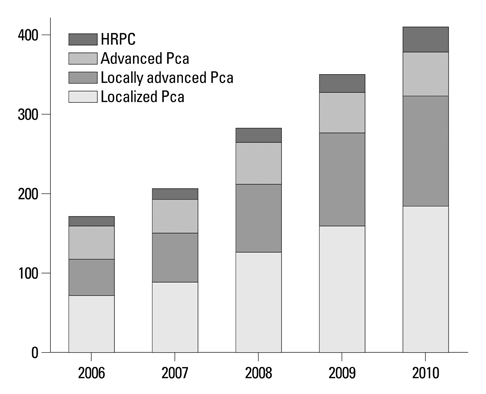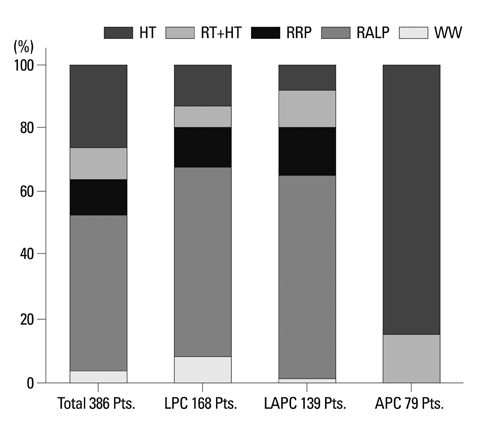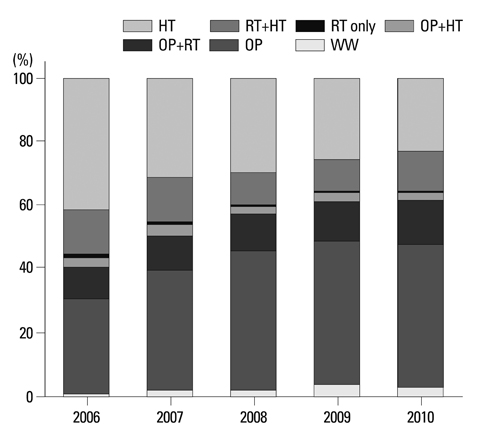The Change of Prostate Cancer Treatment in Korea: 5 Year Analysis of a Single Institution
- Affiliations
-
- 1Department of Urology and Urological Science Institute, Gangnam Severance Hospital, Yonsei University College of Medicine, Seoul, Korea. chung646@yuhs.ac
- KMID: 1776922
- DOI: http://doi.org/10.3349/ymj.2013.54.1.87
Abstract
- PURPOSE
We analyzed changes to the trends of prostate cancer management and patient characteristics at a single institute during 5 years due to the significant increase of the prostate cancer incidence and the robotic equipment in Korea.
MATERIALS AND METHODS
Prostate cancer patient data from a single institute recorded from 2006 to 2010 were analyzed. Cancer stage, initial treatment modalities, and the pattern of outpatient clinical management were reviewed.
RESULTS
Between 2006 and 2010, 386 prostate cancers were newly diagnosed at the institute. The proportion of localized and locally advanced cancer cases increased from 67% in 2006 to 79% in 2010 respectively. Among the treatment choices during follow-up in the out-patients clinic, the proportion of radical prostatectomies increased from 43% in 2006 to 62% in 2010. In contrast, the proportion of hormone therapies decreased from 58% to 37%. For initial treatment choice, radical prostatectomy was chosen for 59% of the patients who were newly diagnosed with cancer during the study period. However, hormone therapy alone was administrated as a primary therapy to 26%. Analysis of the radical prostatectomy subgroup showed that a robot-assisted technique was used in 83% of the patients, and the remaining 17% underwent an open radical prostatectomy.
CONCLUSION
As the prostate cancer incidence increased in Korea, the proportion of localized and locally advanced cancer also increased. In addition, the main treatment modality changed from non-surgical treatment to radical prostatectomy.
Keyword
MeSH Terms
Figure
Cited by 8 articles
-
Changes in Clinical Characteristics of Patients with an Initial Diagnosis of Prostate Cancer in Korea: 10-Year Trends Reported by a Tertiary Center
Ji Eun Heo, Hyun Kyu Ahn, Jinu Kim, Byung Ha Chung, Kwang Suk Lee
J Korean Med Sci. 2018;33(6):. doi: 10.3346/jkms.2018.33.e42.Can Western Based Online Prostate Cancer Risk Calculators Be Used to Predict Prostate Cancer after Prostate Biopsy for the Korean Population?
Dong Hoon Lee, Ha Bum Jung, Jae Won Park, Kyu Hyun Kim, Jongchan Kim, Seung Hwan Lee, Byung Ha Chung
Yonsei Med J. 2013;54(3):665-671. doi: 10.3349/ymj.2013.54.3.665.Is High-Dose Leuprorelin Acetate Effective and Safe in Asian Men with Prostate Cancer? An Open-Label, Non-Comparative, Multi-Center Clinical Trial
Seung-Hwan Lee, Hyun-Moo Lee, Sae-Woong Kim, Eun-Sik Lee, Sung-Joon Hong, Choung-Soo Kim, Taek-Won Kang, Byung-Ha Chung
Yonsei Med J. 2014;55(2):310-315. doi: 10.3349/ymj.2014.55.2.310.Simultaneous Robot-Assisted Laparoendoscopic Single-Site Partial Nephrectomy and Standard Radical Prostatectomy
Jae Hung Jung, Hong Wook Kim, Cheol Kyu Oh, Jae Mann Song, Byung Ha Chung, Sung Joon Hong, Koon Ho Rha
Yonsei Med J. 2014;55(2):535-538. doi: 10.3349/ymj.2014.55.2.535.Enzalutamide in chemotherapy-naive patients with metastatic castration-resistant prostate cancer: A retrospective Korean multicenter study in a real-world setting
Seung Il Jung, Myung Soo Kim, Chang Wook Jeong, Cheol Kwak, Sung Kyu Hong, Seok Ho Kang, Jae Young Joung, Seung Hwan Lee, Seok Joong Yun, Tae-Hwan Kim, Sung Woo Park, Seong Soo Jeon, Minyong Kang, Ji Youl Lee, Byung Ha Chung, Jun Hyuk Hong, Hanjong Ahn, Choung-Soo Kim, Dong Deuk Kwon
Investig Clin Urol. 2020;61(1):19-27. doi: 10.4111/icu.2020.61.1.19.Time to Disease Recurrence Is a Predictor of Metastasis and Mortality in Patients with High-risk Prostate Cancer Who Achieved Undetectable Prostate-specific Antigen Following Robot-assisted Radical Prostatectomy
Do Kyung Kim, Kyo Chul Koo, Kwang Suk Lee, Yoon Soo Hah, Koon Ho Rha, Sung Joon Hong, Byung Ha Chung
J Korean Med Sci. 2018;33(45):. doi: 10.3346/jkms.2018.33.e285.Efficacy and Safety of Robotic Procedures Performed Using the da Vinci Robotic Surgical System at a Single Institute in Korea: Experience with 10000 Cases
Dong Hoon Koh, Won Sik Jang, Jae Won Park, Won Sik Ham, Woong Kyu Han, Koon Ho Rha, Young Deuk Choi
Yonsei Med J. 2018;59(8):975-981. doi: 10.3349/ymj.2018.59.8.975.A Nationwide Study of Differences in Surgical Treatment Rates and Oncological Outcomes for Prostate Cancer according to Economic Status and Region
Sangjun Yoo, Sohee Oh, Min Chul Cho, Hwancheol Son, Hyeon Jeong
Cancer Res Treat. 2023;55(2):652-658. doi: 10.4143/crt.2022.893.
Reference
-
1. Parkin DM, Pisani P, Ferlay J. Global cancer statistics. CA Cancer J Clin. 1999. 49:33–64. 1
Article2. Sim HG, Cheng CW. Changing demography of prostate cancer in Asia. Eur J Cancer. 2005. 41:834–845.
Article3. Statistics Korea. [http://kostat.go.kr/portal/english/index.action].4. Jung KW, Park S, Kong HJ, Won YJ, Boo YK, Shin HR, et al. Cancer statistics in Korea: incidence, mortality and survival in 2006-2007. J Korean Med Sci. 2010. 25:1113–1121.
Article5. Park SK, Sakoda LC, Kang D, Chokkalingam AP, Lee E, Shin HR, et al. Rising prostate cancer rates in South Korea. Prostate. 2006. 66:1285–1291.
Article6. Dasgupta P, Kirby RS. The current status of robot-assisted radical prostatectomy. Asian J Androl. 2009. 11:90–93.
Article7. Sung ER, Jeong W, Park SY, Ham WS, Choi YD, Hong SJ, et al. The "halo effect" in Korea: change in practice patterns since the introduction of robot-assisted laparoscopic radical prostatectomy. J Robot Surg. 2009. 3:57–60.
Article8. National Evidence-based healthcare collaborating Agency (NECA), Korea. [http://www.neca.re.kr/eng].9. Korea Ministry of Health and Welfare. National health insurance system. [http://english.mw.go.kr/front_eng/index.jSP].10. Akaza H, Hinotsu S, Usami M, Ogawa O, Kagawa S, Kitamura T, et al. The case for androgen deprivation as primary therapy for early stage disease: results from J-CaP and CaPSURE. J Urol. 2006. 176(6 Pt 2):S47–S49.
Article11. Hamilton AS, Albertsen PC, Johnson TK, Hoffman R, Morrell D, Deapen D, et al. Trends in the treatment of localized prostate cancer using supplemented cancer registry data. BJU Int. 2011. 107:576–584.
Article12. McVey GP, McPhail S, Fowler S, McIntosh G, Gillatt D, Parker CC. Initial management of low-risk localized prostate cancer in the UK: analysis of the British Association of Urological Surgeons Cancer Registry. BJU Int. 2010. 106:1161–1164.
Article13. Akaza H. Trends in primary androgen depletion therapy for patients with localized and locally advanced prostate cancer: Japanese perspective. Cancer Sci. 2006. 97:243–247.
Article14. Hinotsu S, Akaza H, Usami M, Ogawa O, Kagawa S, Kitamura T, et al. Current status of endocrine therapy for prostate cancer in Japan analysis of primary androgen deprivation therapy on the basis of data collected by J-CaP. Jpn J Clin Oncol. 2007. 37:775–781.
Article15. National Comprehensive Cancer Network® (NCCN). NCCN clinical practice guidelines in oncology: Asia consensus statement: prostate cancer. [http://www.nccn.org/professionals/physician_gls/PDF/prostate-asia.pdf].16. Cooperberg MR, Broering JM, Carroll PR. Time trends and local variation in primary treatment of localized prostate cancer. J Clin Oncol. 2010. 28:1117–1123.
Article17. Lubeck DP, Litwin MS, Henning JM, Stier DM, Mazonson P, Fisk R, et al. The CaPSURE database: a methodology for clinical practice and research in prostate cancer. CaPSURE Research Panel. Cancer of the Prostate Strategic Urologic Research Endeavor. Urology. 1996. 48:773–777.
Article18. Akaza H, Usami M, Hinotsu S, Ogawa O, Kagawa S, Kitamura T, et al. Characteristics of patients with prostate cancer who have initially been treated by hormone therapy in Japan: J-CaP surveillance. Jpn J Clin Oncol. 2004. 34:329–336.
Article
- Full Text Links
- Actions
-
Cited
- CITED
-
- Close
- Share
- Similar articles
-
- Clinical Significance of a Single-Core Positive Prostate Cancers Detected on Extended Prostate Needle Biopsy
- The Prostate Cancer Detection Rate on the Second Prostate Biopsy according to Prostate-Specific Antigen Trend
- Change of serum prostate specific antigen values after radiation therapy in prostate cancer
- An Update of Prostate-Specific Membrane Antigen Theranostics in Prostate Cancer
- Focal therapy for prostate cancer with irreversible electroporation: Oncological and functional results of a single institution study




